Applying Communication Theory: An Analysis of a Bar Interaction
VerifiedAdded on 2023/06/12
|5
|961
|292
Essay
AI Summary
This essay provides an analysis of a communication event observed in a crowded bar between a waiter and a drunk customer. The analysis focuses on the application of three key communication theories: verbal and non-verbal cues, body language, and noise (both physical and psychological). The essay details how these theories manifest in the interaction, such as the customer's shouting (verbal communication) met with the waiter's pointing (non-verbal cue), the waiter's assessment of the customer's drunkenness through body language, and the impact of physical noise in the bar on the communication process. The essay concludes by emphasizing the importance of understanding and applying these communication theories for effective interaction and information transfer.
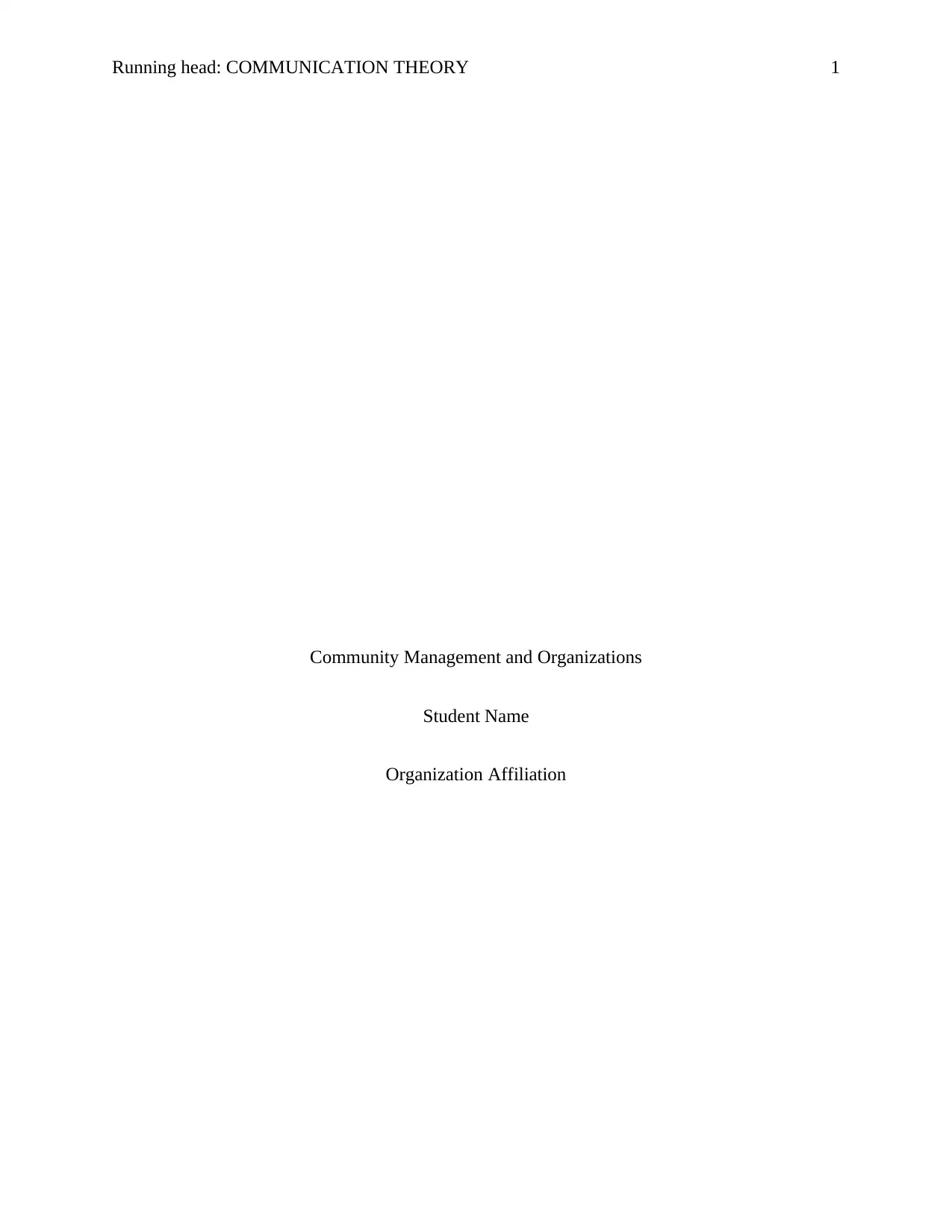
Running head: COMMUNICATION THEORY 1
Community Management and Organizations
Student Name
Organization Affiliation
Community Management and Organizations
Student Name
Organization Affiliation
Paraphrase This Document
Need a fresh take? Get an instant paraphrase of this document with our AI Paraphraser
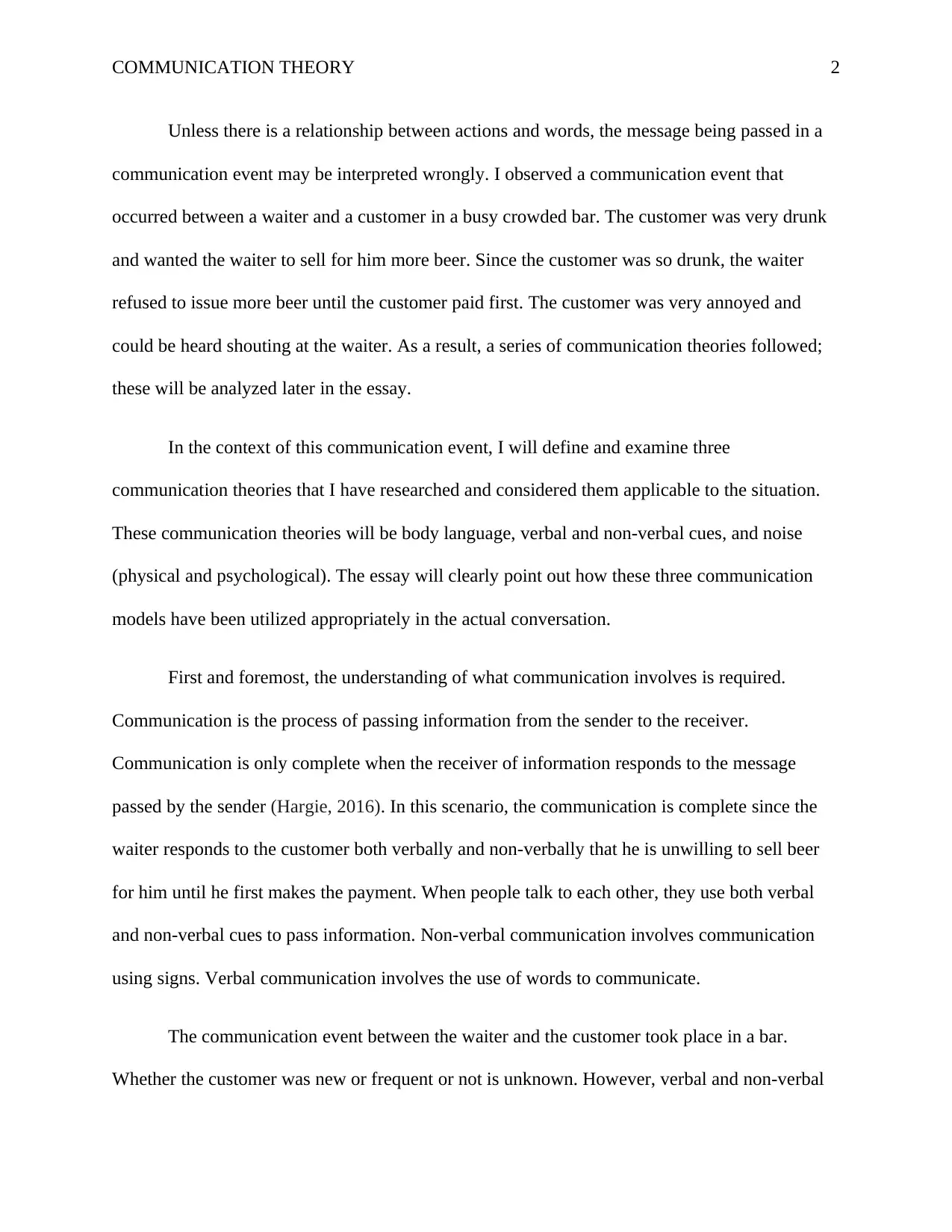
COMMUNICATION THEORY 2
Unless there is a relationship between actions and words, the message being passed in a
communication event may be interpreted wrongly. I observed a communication event that
occurred between a waiter and a customer in a busy crowded bar. The customer was very drunk
and wanted the waiter to sell for him more beer. Since the customer was so drunk, the waiter
refused to issue more beer until the customer paid first. The customer was very annoyed and
could be heard shouting at the waiter. As a result, a series of communication theories followed;
these will be analyzed later in the essay.
In the context of this communication event, I will define and examine three
communication theories that I have researched and considered them applicable to the situation.
These communication theories will be body language, verbal and non-verbal cues, and noise
(physical and psychological). The essay will clearly point out how these three communication
models have been utilized appropriately in the actual conversation.
First and foremost, the understanding of what communication involves is required.
Communication is the process of passing information from the sender to the receiver.
Communication is only complete when the receiver of information responds to the message
passed by the sender (Hargie, 2016). In this scenario, the communication is complete since the
waiter responds to the customer both verbally and non-verbally that he is unwilling to sell beer
for him until he first makes the payment. When people talk to each other, they use both verbal
and non-verbal cues to pass information. Non-verbal communication involves communication
using signs. Verbal communication involves the use of words to communicate.
The communication event between the waiter and the customer took place in a bar.
Whether the customer was new or frequent or not is unknown. However, verbal and non-verbal
Unless there is a relationship between actions and words, the message being passed in a
communication event may be interpreted wrongly. I observed a communication event that
occurred between a waiter and a customer in a busy crowded bar. The customer was very drunk
and wanted the waiter to sell for him more beer. Since the customer was so drunk, the waiter
refused to issue more beer until the customer paid first. The customer was very annoyed and
could be heard shouting at the waiter. As a result, a series of communication theories followed;
these will be analyzed later in the essay.
In the context of this communication event, I will define and examine three
communication theories that I have researched and considered them applicable to the situation.
These communication theories will be body language, verbal and non-verbal cues, and noise
(physical and psychological). The essay will clearly point out how these three communication
models have been utilized appropriately in the actual conversation.
First and foremost, the understanding of what communication involves is required.
Communication is the process of passing information from the sender to the receiver.
Communication is only complete when the receiver of information responds to the message
passed by the sender (Hargie, 2016). In this scenario, the communication is complete since the
waiter responds to the customer both verbally and non-verbally that he is unwilling to sell beer
for him until he first makes the payment. When people talk to each other, they use both verbal
and non-verbal cues to pass information. Non-verbal communication involves communication
using signs. Verbal communication involves the use of words to communicate.
The communication event between the waiter and the customer took place in a bar.
Whether the customer was new or frequent or not is unknown. However, verbal and non-verbal
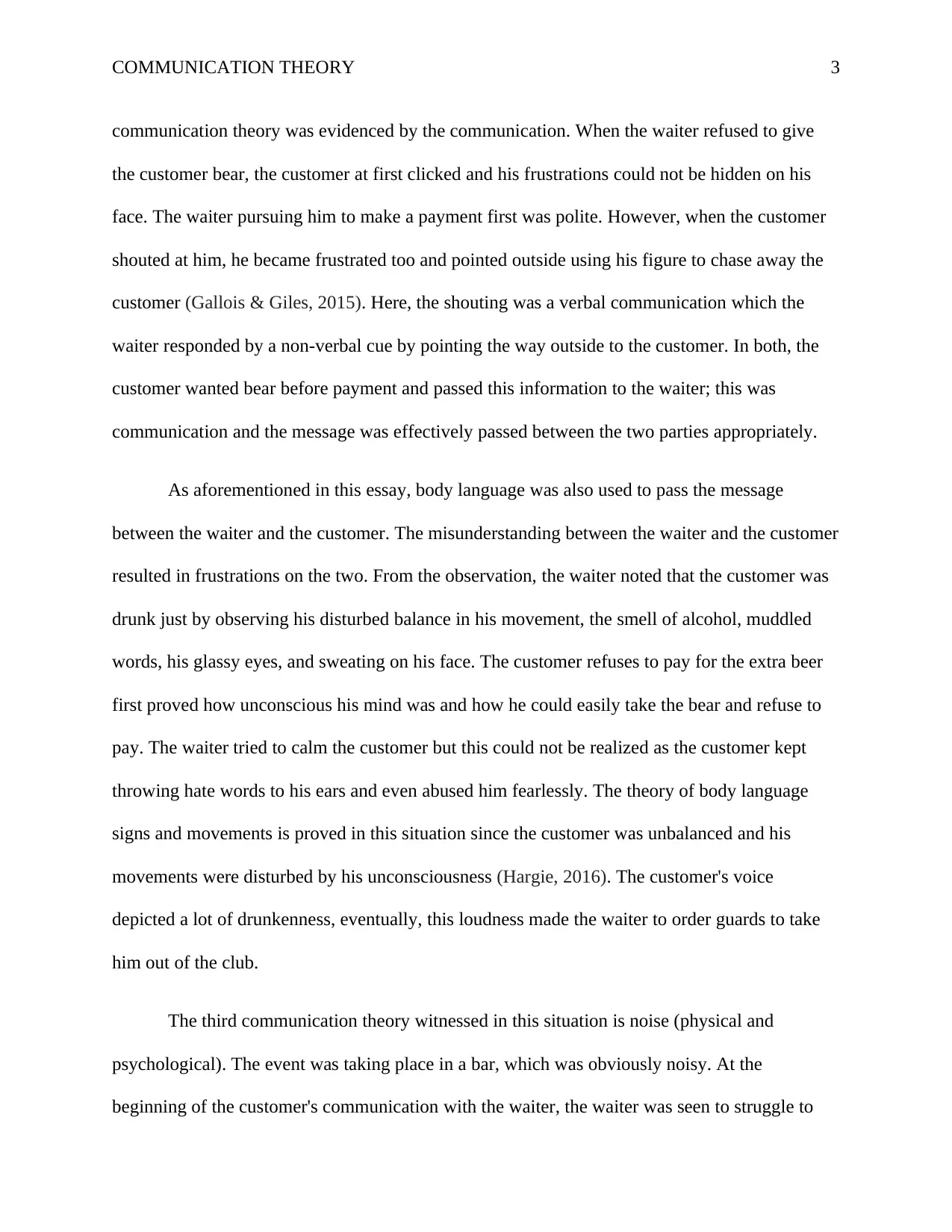
COMMUNICATION THEORY 3
communication theory was evidenced by the communication. When the waiter refused to give
the customer bear, the customer at first clicked and his frustrations could not be hidden on his
face. The waiter pursuing him to make a payment first was polite. However, when the customer
shouted at him, he became frustrated too and pointed outside using his figure to chase away the
customer (Gallois & Giles, 2015). Here, the shouting was a verbal communication which the
waiter responded by a non-verbal cue by pointing the way outside to the customer. In both, the
customer wanted bear before payment and passed this information to the waiter; this was
communication and the message was effectively passed between the two parties appropriately.
As aforementioned in this essay, body language was also used to pass the message
between the waiter and the customer. The misunderstanding between the waiter and the customer
resulted in frustrations on the two. From the observation, the waiter noted that the customer was
drunk just by observing his disturbed balance in his movement, the smell of alcohol, muddled
words, his glassy eyes, and sweating on his face. The customer refuses to pay for the extra beer
first proved how unconscious his mind was and how he could easily take the bear and refuse to
pay. The waiter tried to calm the customer but this could not be realized as the customer kept
throwing hate words to his ears and even abused him fearlessly. The theory of body language
signs and movements is proved in this situation since the customer was unbalanced and his
movements were disturbed by his unconsciousness (Hargie, 2016). The customer's voice
depicted a lot of drunkenness, eventually, this loudness made the waiter to order guards to take
him out of the club.
The third communication theory witnessed in this situation is noise (physical and
psychological). The event was taking place in a bar, which was obviously noisy. At the
beginning of the customer's communication with the waiter, the waiter was seen to struggle to
communication theory was evidenced by the communication. When the waiter refused to give
the customer bear, the customer at first clicked and his frustrations could not be hidden on his
face. The waiter pursuing him to make a payment first was polite. However, when the customer
shouted at him, he became frustrated too and pointed outside using his figure to chase away the
customer (Gallois & Giles, 2015). Here, the shouting was a verbal communication which the
waiter responded by a non-verbal cue by pointing the way outside to the customer. In both, the
customer wanted bear before payment and passed this information to the waiter; this was
communication and the message was effectively passed between the two parties appropriately.
As aforementioned in this essay, body language was also used to pass the message
between the waiter and the customer. The misunderstanding between the waiter and the customer
resulted in frustrations on the two. From the observation, the waiter noted that the customer was
drunk just by observing his disturbed balance in his movement, the smell of alcohol, muddled
words, his glassy eyes, and sweating on his face. The customer refuses to pay for the extra beer
first proved how unconscious his mind was and how he could easily take the bear and refuse to
pay. The waiter tried to calm the customer but this could not be realized as the customer kept
throwing hate words to his ears and even abused him fearlessly. The theory of body language
signs and movements is proved in this situation since the customer was unbalanced and his
movements were disturbed by his unconsciousness (Hargie, 2016). The customer's voice
depicted a lot of drunkenness, eventually, this loudness made the waiter to order guards to take
him out of the club.
The third communication theory witnessed in this situation is noise (physical and
psychological). The event was taking place in a bar, which was obviously noisy. At the
beginning of the customer's communication with the waiter, the waiter was seen to struggle to
⊘ This is a preview!⊘
Do you want full access?
Subscribe today to unlock all pages.

Trusted by 1+ million students worldwide
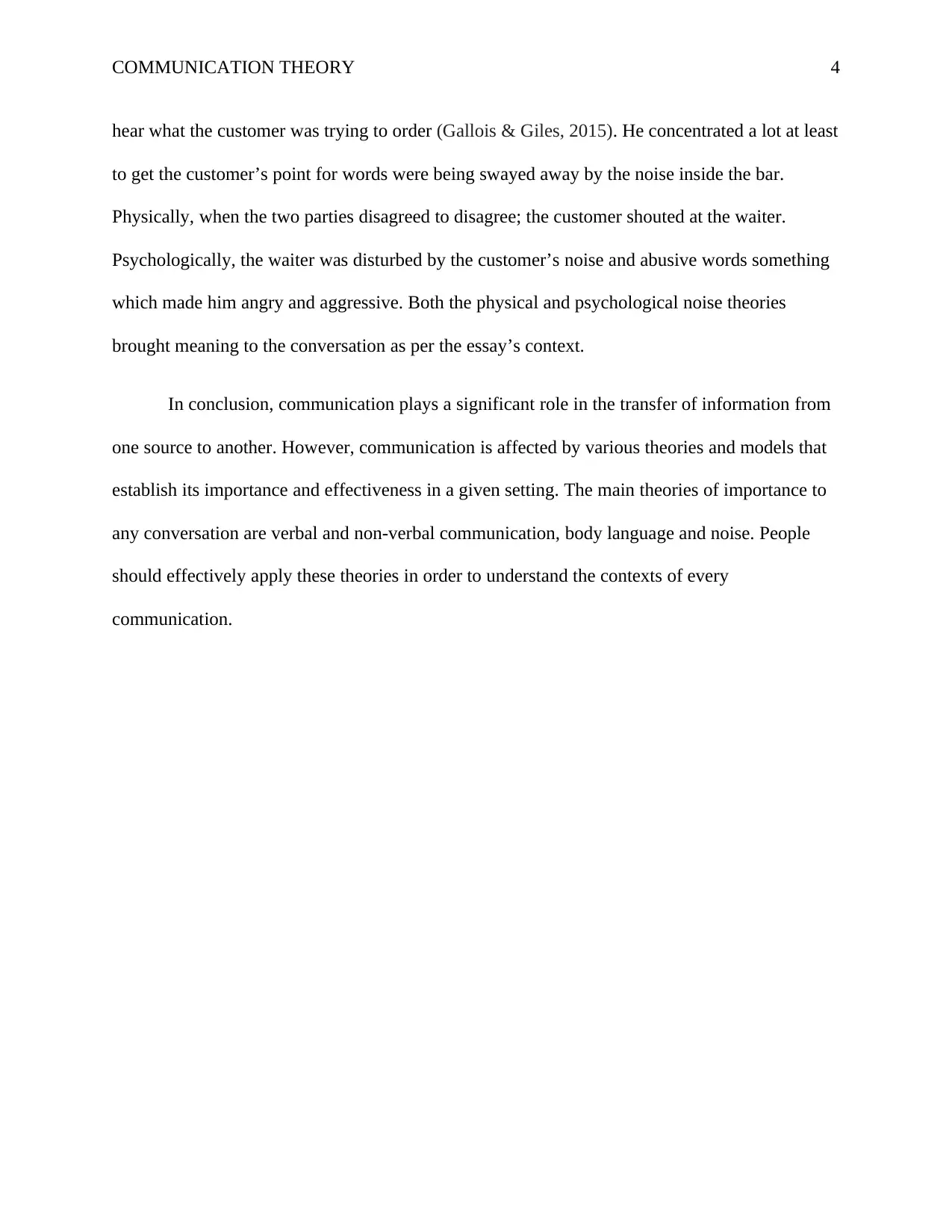
COMMUNICATION THEORY 4
hear what the customer was trying to order (Gallois & Giles, 2015). He concentrated a lot at least
to get the customer’s point for words were being swayed away by the noise inside the bar.
Physically, when the two parties disagreed to disagree; the customer shouted at the waiter.
Psychologically, the waiter was disturbed by the customer’s noise and abusive words something
which made him angry and aggressive. Both the physical and psychological noise theories
brought meaning to the conversation as per the essay’s context.
In conclusion, communication plays a significant role in the transfer of information from
one source to another. However, communication is affected by various theories and models that
establish its importance and effectiveness in a given setting. The main theories of importance to
any conversation are verbal and non-verbal communication, body language and noise. People
should effectively apply these theories in order to understand the contexts of every
communication.
hear what the customer was trying to order (Gallois & Giles, 2015). He concentrated a lot at least
to get the customer’s point for words were being swayed away by the noise inside the bar.
Physically, when the two parties disagreed to disagree; the customer shouted at the waiter.
Psychologically, the waiter was disturbed by the customer’s noise and abusive words something
which made him angry and aggressive. Both the physical and psychological noise theories
brought meaning to the conversation as per the essay’s context.
In conclusion, communication plays a significant role in the transfer of information from
one source to another. However, communication is affected by various theories and models that
establish its importance and effectiveness in a given setting. The main theories of importance to
any conversation are verbal and non-verbal communication, body language and noise. People
should effectively apply these theories in order to understand the contexts of every
communication.
Paraphrase This Document
Need a fresh take? Get an instant paraphrase of this document with our AI Paraphraser
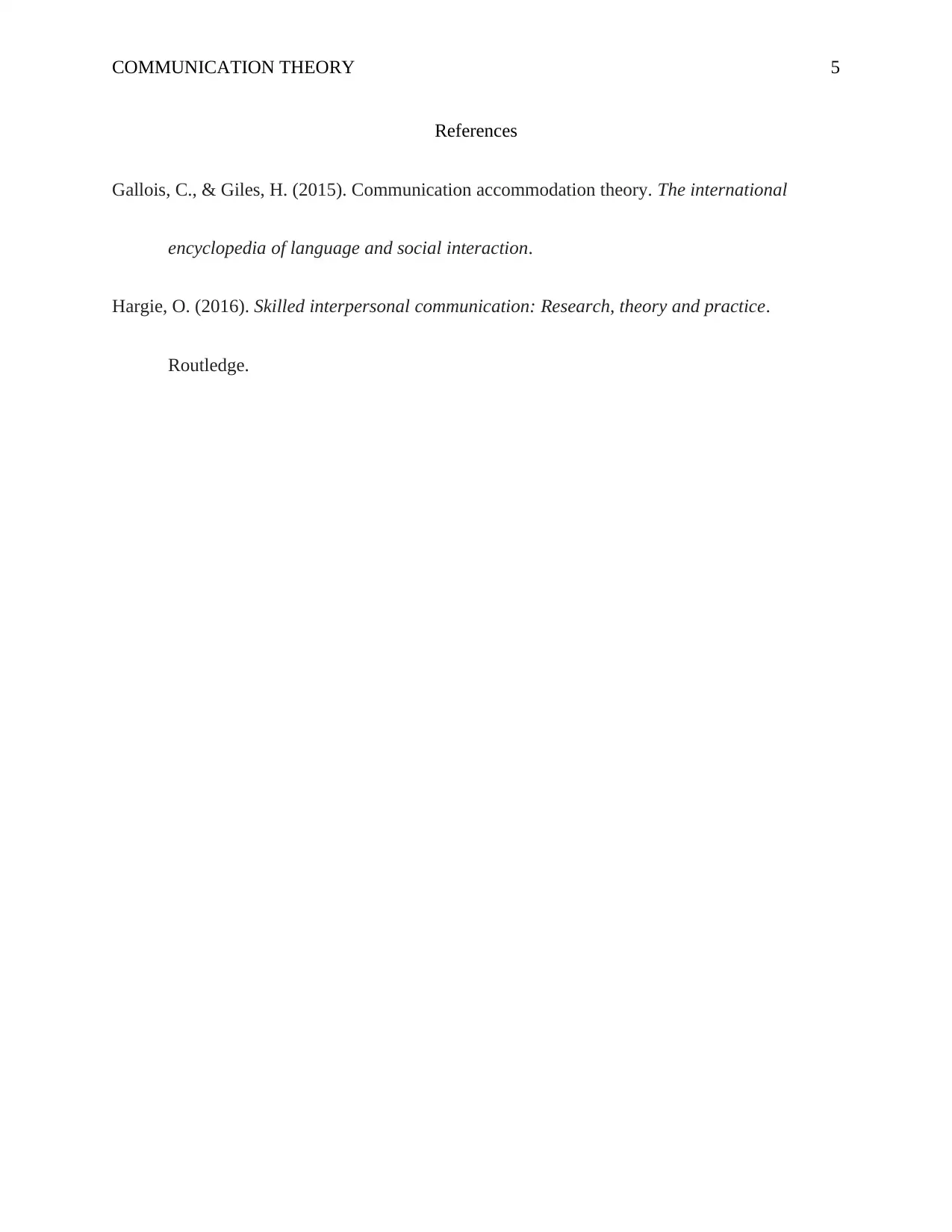
COMMUNICATION THEORY 5
References
Gallois, C., & Giles, H. (2015). Communication accommodation theory. The international
encyclopedia of language and social interaction.
Hargie, O. (2016). Skilled interpersonal communication: Research, theory and practice.
Routledge.
References
Gallois, C., & Giles, H. (2015). Communication accommodation theory. The international
encyclopedia of language and social interaction.
Hargie, O. (2016). Skilled interpersonal communication: Research, theory and practice.
Routledge.
1 out of 5
Related Documents
Your All-in-One AI-Powered Toolkit for Academic Success.
+13062052269
info@desklib.com
Available 24*7 on WhatsApp / Email
![[object Object]](/_next/static/media/star-bottom.7253800d.svg)
Unlock your academic potential
Copyright © 2020–2025 A2Z Services. All Rights Reserved. Developed and managed by ZUCOL.



